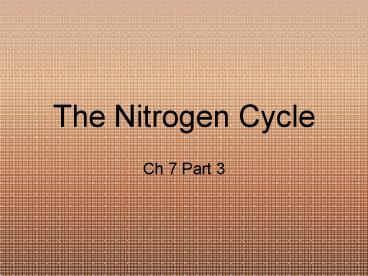The Nitrogen Cycle PowerPoint PPT Presentation
1 / 24
Title: The Nitrogen Cycle
1
The Nitrogen Cycle
- Ch 7 Part 3
2
Nitrogen Cycle
- Nitrogen cycle the routes that nitrogen atoms
take through the environment - Nitrogen gas (N2) is the most abundant gas in the
atmosphere (78) - Nitrogen gas is inert cannot be used directly
by most organisms. - Nitrogen is cycled through animals, soil,
gases. - Organisms use nitrogen (in various forms) to make
vital organic compounds. - Nitrogen is an important component of biological
molecules DNA, RNA, proteins. - Nitrogen is a plant nutrient acts as a limiting
factor for plant growth. - Too much nitrogen in aquatic systems can cause
eutrophication.
3
- Several steps
- Nitrogen fixation
- nitrogen to ammonia
- Nitrification
- ammonia to nitrates
- Assimilation
- nitrates to proteins, DNA, RNA, etc.
- Ammonification
- decomposition
- Denitrification
- ammonia nitrates to nitrogen
- Abbreviations to know
- nitrogen gas (N2)
- ammonia (NH3)
- ammonium ions (NH4)
- nitrite ions (NO2-)
- nitrate ions (NO3-)
4
Nitrogen Fixation
- Even though N2 is the most abundant gas in the
atmosphere (78) it must be fixed or converted
into a usable form before it can be absorbed and
used by multicellular organisms. - Ways of converting N2
- 1. lightning
- causes reaction with O2 to form NO3-
- 2. Nitrogen fixation N2 is combined (fixed) with
H2 to become ammonia, NH3 - whose water-soluble ions of ammonium, NH4, can
be taken up by plants - Done by nitrogen-fixing bacteria
5
Nitrogen Fixation
- Specialized bacteria convert N2 gas to ammonia
(NH3) - N2 3H2 ? 2NH3
- Once converted into ammonia, water-soluble ions
in the form of ammonium (NH4) can be taken up by
plants - Done mostly by
- Cyanobacteria in soil water
- Rhizobium bacteria in nodules on roots of wide
variety of plants - (ex. legumes, soybeans,
- alfalfa)
- Requires large amounts of energy
6
Nitrification
- Nitrification bacteria convert ammonium ions,
NH4 (the water soluble form of ammonia, NH3,
which is usually produced by decay) through a
2-step process into NO2- (nitrite) NO3-
(nitrate) - Done by 2 groups of specialized aerobic
nitrifying bacteria (for use by plants) to - 1. Nitrite ions (NO2-)
- toxic to plants
- Nitrosomonas
- Nitrosococcus
- 2. Nitrate ions (NO3-)
- easily taken up by plants
as a
nutrient through roots - Nitrobacter
7
(No Transcript)
8
Assimilation
- Plant roots absorb inorganic ammonia (NH3),
ammonium ions (NH4), nitrate ions (NO3-). - Formed by nitrification (NH3 ? NH4 ? NO2- ?
NO3-) nitrogen fixation (N2 3H2 ? 2NH3). - Ions are used to make
- N-containing organic
- molecules such as
- DNA RNA
- Amino Acids
- Proteins
- Animals get their N by eating plants or
plant-eating animals
Assimilation
NH3
9
Ammonification
- Bacteria in soil water decompose N-rich organic
compounds, wastes, cast-off particles dead
organisms into - 1. simpler N-containing inorganic compounds such
as ammonia (NH3) - 2. water-soluble salts containing ammonium ions
(NH4)
10
Denitrification
- Dentrification other specialized bacteria
convert ammonia back into gaseous nitrogen
through a multistep process - Ammonia (NH3) ammonium ions (NH4) ? nitrite
ions (NO2-) nitrate ions (NO3-) ? nitrogen gas
(N2) nitrous oxide gas (N2O) - Done by denitrifying bacteria deep in soil
aquatic sediments - Anaerobic conditions So use nitrates as an
alternative to oxygen for the final electron
acceptor in their respiration. - Replenish atmosphere close the nitrogen cycle
11
Humans Affect the Nitrogen Cycle
- Haber-Bosch process synthetic production of
fertilizers by combining nitrogen hydrogen to
synthesize ammonia - Dramatically changed the nitrogen cycle since
devised in 1950s - huge increases in crop yields (due to
fertilization)cheaply - Humans are fixing more nitrogen than nature does
- Reduced biodiversity of plants adapted to
low-nitrogen soils - Calcium potassium in soil washed out by
fertilizers (depletion) - Acidified water soils
- Disposing of N-rich municipal sewage
- Raising cattle in feedlots adjacent to waterways
(wastes in runoff) - Changed estuaries coastal ecosystems
fisheries - N in run-off causes bloom in algae aquatic
plants (eutrophication) - When photosythesizers die in the water their
decomposition by bacteria removes O2 from the
water (hypoxia) causes death of other
organisms. - Burning fossil fuels grasslands deforestation
removes N from the soil produces NOx (a
precursor for acid rain ozone depletion)
12
Effects of Human Activities on the Nitrogen Cycle
- Human activities such as production of
fertilizers now fix more nitrogen than all
natural sources combined.
13
Human Inputs of N Into the Environment
Fully half of nitrogen entering the environment
is of human origin
14
(No Transcript)
15
(No Transcript)
16
(No Transcript)
17
The Nitrogen Cycle
18
(No Transcript)
19
(No Transcript)
20
(No Transcript)
21
(No Transcript)
22
(No Transcript)
23
(No Transcript)
24
Nitrogen Cycle Animation
N Cycle Tutorial
N Cycle Animation

